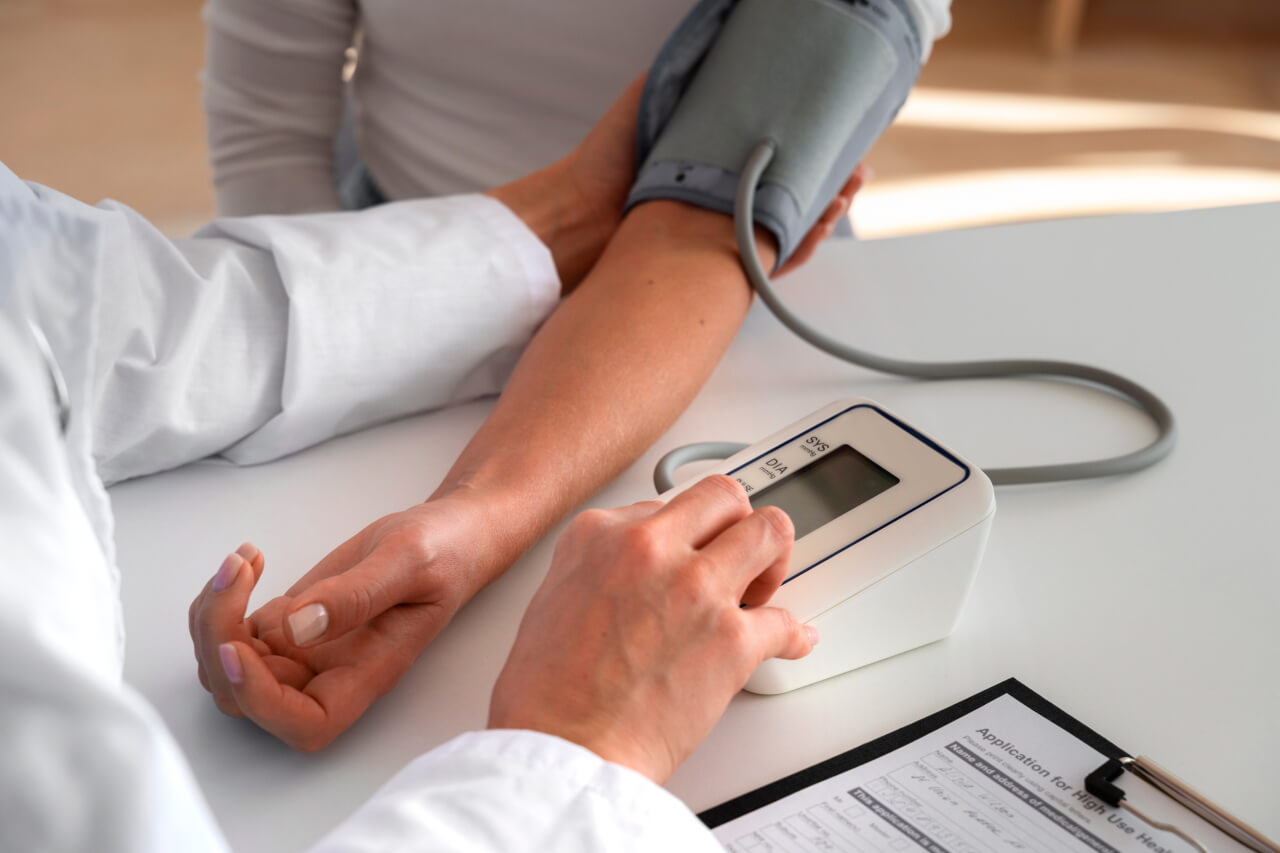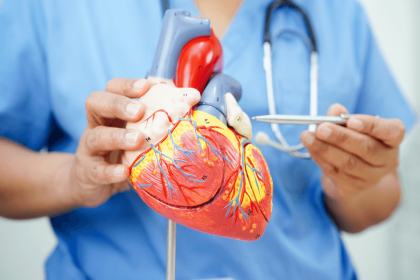Blood pressure refers to the force exerted by the blood against the walls of your blood vessels, particularly the arteries, as it is pumped through the body. It is expressed in millimeters of mercury (mmHg) and is usually measured using two values – systolic pressure over diastolic pressure.
The systolic pressure represents the force exerted on the arterial walls when the heart contracts, while the diastolic pressure represents the force when the heart is at rest between beats. Blood pressure is an important measure of cardiovascular health and is influenced by various factors including age, lifestyle, genetics, and underlying medical conditions.
Learn more about blood vessels and circulation from here.
High blood pressure
High blood pressure, also known as hypertension, is a condition where the force of blood against the walls of the arteries is consistently too high.
It is usually defined as having a blood pressure reading of 130/80 mmHg or higher. High blood pressure is a significant health concern because it can put extra strain on the heart and blood vessels, increasing the risk of serious complications such as heart disease, stroke, kidney problems, and other cardiovascular conditions.
Some common factors that contribute to high blood pressure include genetics, age, obesity, lack of physical activity, unhealthy diet (high in salt and low in potassium), excessive alcohol consumption, chronic stress, and certain medical conditions such as diabetes or kidney disease.
Treatment and management of high blood pressure often involve lifestyle changes (such as regular exercise, healthy eating, weight loss) and medication prescribed by a healthcare professional.
Symptoms
High blood pressure is often referred to as the “silent killer” because it typically does not cause noticeable symptoms. Many people may have high blood pressure for years without knowing it. The lack of symptoms is why regular blood pressure checks are essential for detecting and managing the condition.
In some cases, extremely high blood pressure can cause symptoms such as:
- Headaches
- Shortness of breath
- Dizziness
- Chest pain
- Nosebleeds
Harmful effects
High blood pressure can have several harmful effects on the body, including:
Cardiovascular Disease
High blood pressure puts added strain on the heart and blood vessels, increasing the risk of heart disease, heart attack, and stroke.
Kidney Damage
Uncontrolled high blood pressure can damage the blood vessels in the kidneys, leading to kidney disease or even kidney failure.
Eye Problems
Chronically high blood pressure can damage the blood vessels in the eyes, leading to vision problems or even blindness.
Aneurysm
High blood pressure can weaken the walls of the blood vessels, potentially causing them to bulge and form an aneurysm. Aneurysms can burst, leading to severe internal bleeding and, in some cases, life-threatening complications.
Cognitive Decline
Long-term high blood pressure can contribute to the development of vascular dementia or other cognitive impairments.
Peripheral Artery Disease
High blood pressure can lead to the narrowing or blockage of blood vessels in the limbs, reducing blood flow and increasing the risk of infections, slow wound healing, and even amputation in severe cases.
How to Manage
Managing high blood pressure involves a combination of lifestyle changes and, in some cases, medication. Here are some strategies to help manage high blood pressure:
Regular Blood Pressure Monitoring
Regularly check your blood pressure at home or visit a healthcare professional for regular check-ups.
Healthy Diet
Follow the Dietary Approaches to Stop Hypertension (DASH) eating plan, which emphasizes fruits, vegetables, whole grains, lean proteins, and low-fat dairy products. Limit your intake of salt/sodium, saturated fats, trans fats, and cholesterol.
Maintain a Healthy Weight
Losing excess weight and maintaining a healthy weight can positively impact blood pressure. Consult with a healthcare professional or registered dietitian for guidance.
Regular Physical Activity
Engage in aerobic exercises such as brisk walking, jogging, swimming, or cycling for at least 150 minutes per week. Additionally, incorporate strength training exercises twice a week.
Limit Alcohol Consumption
Moderate your alcohol intake, as excessive drinking can raise blood pressure. Men should limit to two drinks per day, while women should limit to one drink per day.
Reduce Sodium Intake
Limit your sodium intake by choosing fresh, unprocessed foods, using herbs and spices to flavor meals instead of salt, and checking food labels for sodium content.
Quit Smoking
Smoking can raise blood pressure and damage blood vessels. Quitting smoking can improve blood pressure and overall health.
Manage Stress
Find healthy ways to cope with stress such as practicing relaxation techniques, engaging in hobbies, or seeking support from friends and family.
Medication
In some cases, lifestyle changes alone may not be sufficient to manage high blood pressure. Consult with a healthcare professional who may prescribe medication to help lower blood pressure.
It’s important to consult with a healthcare professional for personalized advice and guidance in managing high blood pressure. They can assess your individual condition and create a tailored plan for you.
Conclusion
High blood pressure, or hypertension, is a common health condition that can have serious implications if left unmanaged. It is often referred to as the “silent killer” because it typically does not present noticeable symptoms. However, the effects of high blood pressure can be harmful and even life-threatening, including an increased risk of cardiovascular disease, kidney damage, eye problems, aneurysms, cognitive decline, and peripheral artery disease.
Fortunately, high blood pressure can be effectively managed through a combination of lifestyle changes and, when necessary, medication. Regular blood pressure monitoring, adopting a healthy diet, maintaining a healthy weight, engaging in regular physical activity, limiting alcohol consumption, reducing sodium intake, quitting smoking, managing stress, and following a healthcare professional’s guidance for medication can all contribute to managing and controlling high blood pressure.
By implementing these strategies, individuals can reduce their risk and improve their overall health outcomes. It’s important to prioritize regular check-ups, monitor blood pressure levels, and seek professional guidance to ensure effective management. Taking action to manage high blood pressure is vital in protecting against its harmful effects and promoting long-term health and well-being.
FAQs
What is considered high blood pressure?
High blood pressure is typically defined as having a reading of 130/80 mmHg or higher.
What are the symptoms of high blood pressure?
High blood pressure often has no noticeable symptoms, which is why regular blood pressure checks are important. In extreme cases, symptoms may include headaches, shortness of breath, dizziness, chest pain, or nosebleeds.
How can I manage high blood pressure?
Managing high blood pressure involves adopting a healthy lifestyle, including a balanced diet, regular exercise, maintaining a healthy weight, limiting alcohol consumption, reducing sodium intake, managing stress, and following a healthcare professional’s guidance for medication.
Can high blood pressure be cured?
High blood pressure cannot be cured, but it can be effectively managed and controlled through lifestyle changes and, if necessary, medication.
Can I still lead a normal life with high blood pressure?
Yes, with proper management and control of high blood pressure, individuals can lead normal and healthy lives. It’s important to consistently monitor blood pressure levels and follow the recommended lifestyle changes and treatment plan.
Should I take medication for high blood pressure?
The need for medication to manage high blood pressure varies for each individual. Consult with a healthcare professional to determine the most appropriate course of treatment based on your specific condition.
How often should I check my blood pressure?
For individuals with high blood pressure, regular blood pressure checks are recommended. The frequency may vary depending on your healthcare provider’s advice, but it is typically done at least once every few months.
Can lifestyle changes alone lower blood pressure?
For some individuals, lifestyle changes like a healthy diet, regular exercise, weight management, and stress reduction techniques may be sufficient to lower and control blood pressure. However, others may require medication in addition to lifestyle changes.
Is high blood pressure hereditary?
Genetics can play a role in high blood pressure. If your parents or close relatives have high.





